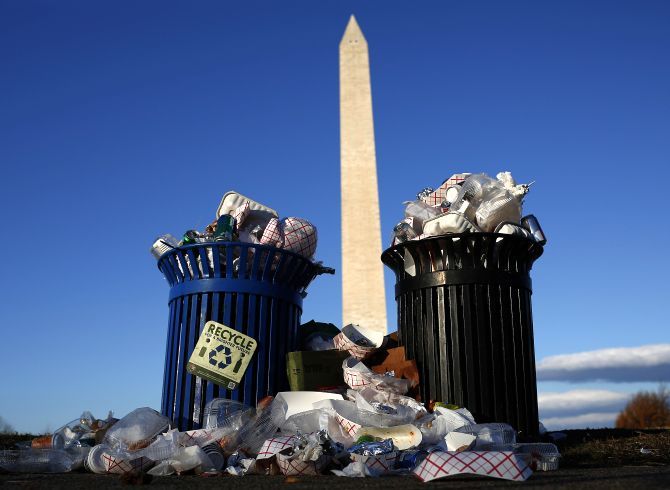A partial United States government shutdown over President Donald Trump’s demand for $5.7 billion to build a wall along the US-Mexico border entered its 23rd day on Sunday making it the longest shuttering of federal agencies in the country’s history, with no end in sight.
The closure, which began on December 22, broke a decades-old record by a 1995-1996 shutdown under former US President Bill Clinton that lasted 21 days.
Take a look at what America appears as during a shutdown, which is a partial one.

The figure of a panda is seen behind a sign telling the public that the National Zoo is closed due to the partial government shutdown in Washington. The partial shutdown of the US federal government began December 22, after US President Donald Trump and Congress failed to agree on funding for the president’s long-sought wall along the US-Mexico border. Photograph: Kevin Lamarque/Reuters

People look inside as a closed sign is seen on a door at Federal Hall National Memorial in New York. Historic sites and national monuments have remained shut during the period. The ones that remain open have limited staffing and have closed access to various park facilities, including restrooms. Photograph: Brendan McDermid/Reuters

Two hikers walk up the main road, which is closed because of the partial government shutdown, in Arches National Park, Utah. The National Park Service is among the agencies hit by the partial shutdown, and all of its parks are affected to different degrees. There are closure alerts for 388 of the 737 parks. On an average day, national parks are expected to collect $400,000 in fee revenue. Since the start of the shutdown, the National Park Conservation Association estimates that the Park Service has lost more than $6 million in fee revenue. Photograph: George Frey/Reuters

An estimated 800,000 federal workers have been affected by the lapse in funding -- either by having to work without pay while it lasts or by being furloughed. Photograph: Carlos Barria/Reuters

A daughter of a US Internal Revenue Services employee holds signs in front of the Federal building at a rally against the ongoing federal government shutdown, in Ogden, Utah. Aside from its effects on workers and local businesses, the shutdown will also reverberate across the US economy. According to S&P Global Ratings, the shutdown could shave approximately $1.2 billion off real GDP for each week that the government is partially closed. Photograph: George Frey/Reuters

"Stop the shutdown!" protesters shout in the bitter cold at the union-organised demonstration that started at the AFL-CIO headquarters and ended in front of 1600 Pennsylvania Avenue, where they hoisted signs reading "Trump: End the Shutdown" and "Not a strike - we want to work." Many furloughed federal workers have turned to online fundraising outlets such as GoFundMe.com to help cover expenses from food to utility bills. Photograph: Kevin Lamarque/Reuters

A closed sign is seen on a fence at the General Grant National Memorial, for former US President Ulysses S Grant, as the government shutdown continues, in Manhattan, New York City. The impact of the shutdown will only worsen the longer it lasts. The nation’s food assistance program has only been assured funding through the end of February. Meanwhile, federal workers appear to be growing frustrated. Transportation Security Administration employees have been increasingly calling in sick at airports across the country while at the Environmental Protection Agency are planning a “national sick day” to protest against the shutdown. Photograph: Mike Segar/Reuters

Trash begins to accumulate along the National Mall near the Washington Monument. Trash removal and general maintenance have been put on hold, leaving sites to fill up with trash. Volunteers are trying their best to keep the places clean, spending hours removing litter and cleaning bathrooms, but they are fighting an uphill battle. Photograph: Win McNamee/Getty Images

A jogger runs up to a vehicle and pedestrian road block that leads to Hains Point at East Potomac Park which is closed due to a partial shutdown of the US government, in Washington, DC. Photograph: Mark Wilson/Getty Images

The normally busy Ronald Reagan Building and International Trade Center adjoining Woodrow Wilson Plaza is mostly quiet as the partial federal government shutdown continues. The area known as Federal Triangle serves as headquarters for the US Customs and Border Protection, the Environmental Protection Agency, the US Agency for International Development and other organisations affected by the shutdown. Photograph: Chip Somodevilla/Getty Images

Tourists Enrico and Latisha Jacomini from Rome, Italy, look at a map after discovering the Smithsonian National Museum of American History is closed due to the partial shutdown of the US government. All 19 of the Smithsonian Institution museums and galleries have been closed since January 3. According to estimates, they may have potentially lost almost 2 million visitors. Photograph: Mark Wilson/Getty Images

A statue of George Washington stands in front of the closed Federal Hall in New York. There’s little hope for a change in situation ass Democrats and US President Donald Trump continue to make little headway in a compromise. Photograph: Spencer Platt/Getty Images











